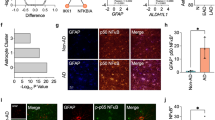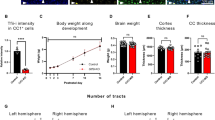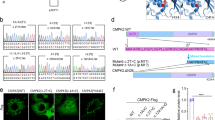Abstract
One of the key signals regulating peripheral myelin formation by Schwann cell is the activation of the transcription factor NF-κB. Yet, whether NF-κB exerts similar functions in central myelin formation by oligodendrocytes remains largely unknown. We previously reported white matter abnormalities with unusual discordance between T2 and FLAIR sequences in a patient with intellectual disability and defective NF-κB signalling. These observations prompted us to hypothesise that NF-κB signalling may have a role in the axon myelination process of central neurons. We report here on five male patients with Xq28 duplications encompassing MECP2, three of which presented white matter anomalies on brain MRI. Array-CGH and FISH analyses demonstrated that brain abnormalities correlate with additional copies of the IKBKG, a gene encoding a key regulator of NF-κB activation. Quantitative RT-PCR experiments and κB-responsive reporter gene assays provide evidence that IKBKG overexpression causes impaired NF-κB signalling in skin fibroblasts derived from patients with white matter anomalies. These data further support the role of NF-κB signalling in astroglial cells for normal myelin formation of the central nervous system.
Similar content being viewed by others
Log in or create a free account to read this content
Gain free access to this article, as well as selected content from this journal and more on nature.com
or
References
Israel A : The IKK complex, a central regulator of NF-kappaB activation. Cold Spring Harb Perspect Biol 2010; 2: a000158.
Pereira JA, Lebrun-Julien F, Suter U : Molecular mechanisms regulating myelination in the peripheral nervous system. Trends in Neurosciences 2012; 35: 123–134.
Nickols JC, Valentine W, Kanwal S, Carter BD : Activation of the transcription factor NF-kappaB in Schwann cells is required for peripheral myelin formation. Nat Neurosci 2003; 6: 161–167.
Aggarwal S, Yurlova L, Simons M : Central nervous system myelin: structure, synthesis and assembly. Trends in Cell Biology 2011; 21: 585–593.
Kremer D, Aktas O, Hartung H-P, Küry P : The complex world of oligodendroglial differentiation inhibitors. Ann Neurol 2011; 69: 602–618.
Philippe O, Rio M, Carioux A et al. Combination of linkage mapping and microarray-expression analysis identifies NF-kappaB signaling defect as a cause of autosomal-recessive mental retardation. Am J Hum Genet 2009; 85: 903–908.
Abou Jamra R, Wohlfart S, Zweier M et al. Homozygosity mapping in 64 Syrian consanguineous families with non-specific intellectual disability reveals 11 novel loci and high heterogeneity. Eur J Hum Genet 2011; 19: 1161–1166.
Koifman A, Feigenbaum A, Bi W et al. A homozygous deletion of 8q24.3 including the NIBP gene associated with severe developmental delay, dysgenesis of the corpus callosum, and dysmorphic facial features. Am J Med Genet A 2010; 152A: 1268–1272.
Marangi G, Leuzzi V, Manti F et al. TRAPPC9-related autosomal recessive intellectual disability: report of a new mutation and clinical phenotype. Eur J Hum Genet 2012; e-pub ahead of print 2 May 2012 doi:10.1038/ejhg.2012.79.
Mir A, Kaufman L, Noor A et al. Identification of mutations in TRAPPC9, which encodes the NIK- and IKK-beta-binding protein, in nonsyndromic autosomal-recessive mental retardation. Am J Hum Genet 2009; 85: 909–915.
Mochida GH, Mahajnah M, Hill AD et al. A truncating mutation of TRAPPC9 is associated with autosomal-recessive intellectual disability and postnatal microcephaly. Am J Hum Genet 2009; 85: 897–902.
Hu WH, Pendergast JS, Mo XM et al. NIBP, a novel NIK and IKK(beta)-binding protein that enhances NF-(kappa)B activation. J Biol Chem 2005; 280: 29233–29241.
Bauters M, Van Esch H, Friez MJ et al. Nonrecurrent MECP2 duplications mediated by genomic architecture-driven DNA breaks and break-induced replication repair. Genome Res 2008; 18: 847–858.
Vandewalle J, Van Esch H, Govaerts K et al. Dosage-dependent severity of the phenotype in patients with mental retardation due to a recurrent copy-number gain at Xq28 mediated by an unusual recombination. Am J Hum Genet 2009; 85: 809–822.
Clayton-Smith J, Walters S, Hobson E et al. Xq28 duplication presenting with intestinal and bladder dysfunction and a distinctive facial appearance. Eur J Hum Genet 2009; 17: 434–443.
Kirk EP, Malaty-Brevaud V, Martini N et al. The clinical variability of the MECP2 duplication syndrome: description of two families with duplications excluding L1CAM and FLNA. Clin Genet 2009; 75: 301–303.
Lugtenberg D, Kleefstra T, Oudakker AR et al. Structural variation in Xq28: MECP2 duplications in 1% of patients with unexplained XLMR and in 2% of male patients with severe encephalopathy. Eur J Hum Genet 2009; 17: 444–453.
Meins M, Lehmann J, Gerresheim F et al. Submicroscopic duplication in Xq28 causes increased expression of the MECP2 gene in a boy with severe mental retardation and features of Rett syndrome. J Med Genet 2005; 42: e12.
Prescott TE, Rodningen OK, Bjornstad A, Stray-Pedersen A : Two brothers with a microduplication including the MECP2 gene: rapid head growth in infancy and resolution of susceptibility to infection. Clin Dysmorphol 2009; 18: 78–82.
Velinov M, Novelli A, Gu H et al. De-novo 2.15 Mb terminal Xq duplication involving MECP2 but not L1CAM gene in a male patient with mental retardation. Clin Dysmorphol 2009; 18: 9–12.
Raasch J, Zeller N, van Loo G et al. IkappaB kinase 2 determines oligodendrocyte loss by non-cell-autonomous activation of NF-kappaB in the central nervous system. Brain 2011; 134: 1184–1198.
Saugier-Veber P, Munnich A, Bonneau D et al. X-linked spastic paraplegia and Pelizaeus-Merzbacher disease are allelic disorders at the proteolipid protein locus. Nat Genet 1994; 6: 257–262.
Gay CT, Hardies LJ, Rauch RA et al. Magnetic resonance imaging demonstrates incomplete myelination in 18q- syndrome: evidence for myelin basic protein haploinsufficiency. Am J Med Genet 1997; 74: 422–431.
Huang CJ, Nazarian R, Lee J, Zhao PM, Espinosa-Jeffrey A, de Vellis J : Tumor necrosis factor modulates transcription of myelin basic protein gene through nuclear factor kappa B in a human oligodendroglioma cell line. Int J Dev Neurosci 2002; 20: 289–296.
Acknowledgements
We are grateful to the patients for their participation in the study. We sincerely acknowledge Elodie Bal for technical assistance and Sylvain Hanein for the gift of the SH-SY5 cell line. This study has been supported by the Centre National de la Recherche Scientifique (CNRS), the Agence Nationale de la Recherche (Grant NOANR-08-MNP-010) and the Ministère de la Recherche et de l’Enseignement Supérieur.
Author information
Authors and Affiliations
Corresponding author
Ethics declarations
Competing interests
The authors declare no conflict of interest.
Rights and permissions
About this article
Cite this article
Philippe, O., Rio, M., Malan, V. et al. NF-κB signalling requirement for brain myelin formation is shown by genotype/MRI phenotype correlations in patients with Xq28 duplications. Eur J Hum Genet 21, 195–199 (2013). https://doi.org/10.1038/ejhg.2012.140
Received:
Revised:
Accepted:
Published:
Issue date:
DOI: https://doi.org/10.1038/ejhg.2012.140
Keywords
This article is cited by
-
Duplication within two regions distal to MECP2: clinical similarity with MECP2 duplication syndrome
BMC Medical Genomics (2023)
-
Reversal of proliferation deficits caused by chromosome 16p13.11 microduplication through targeting NFκB signaling: an integrated study of patient-derived neuronal precursor cells, cerebral organoids and in vivo brain imaging
Molecular Psychiatry (2019)
-
Dysfunctional NF-κB and brain myelin formation
European Journal of Human Genetics (2014)



